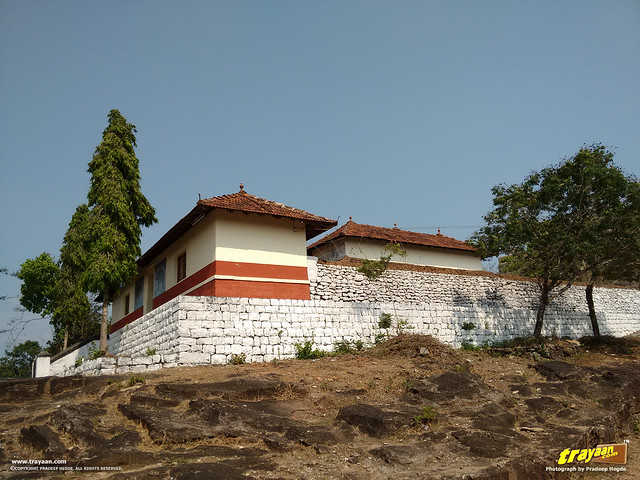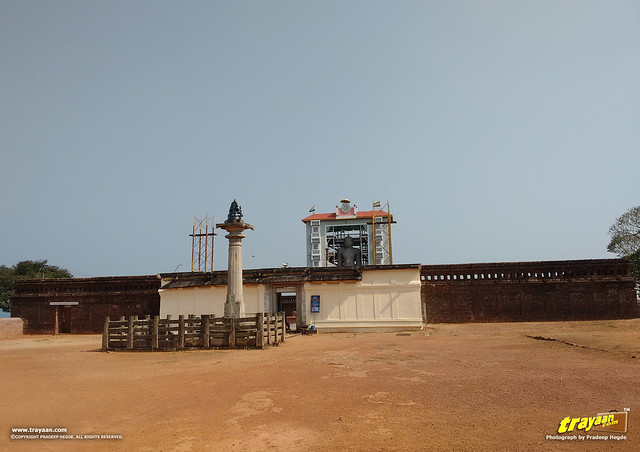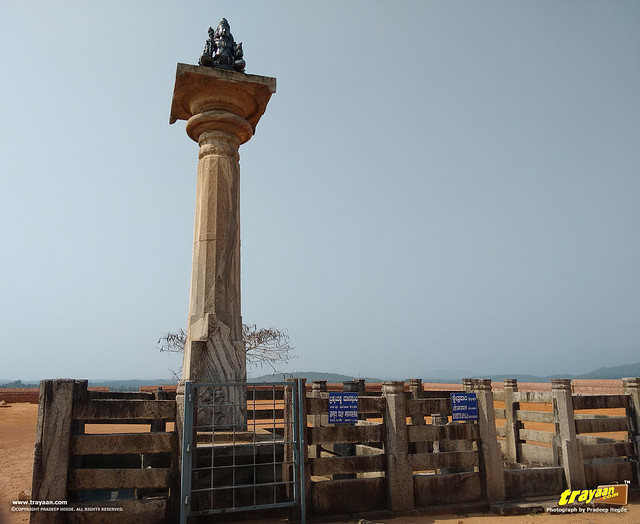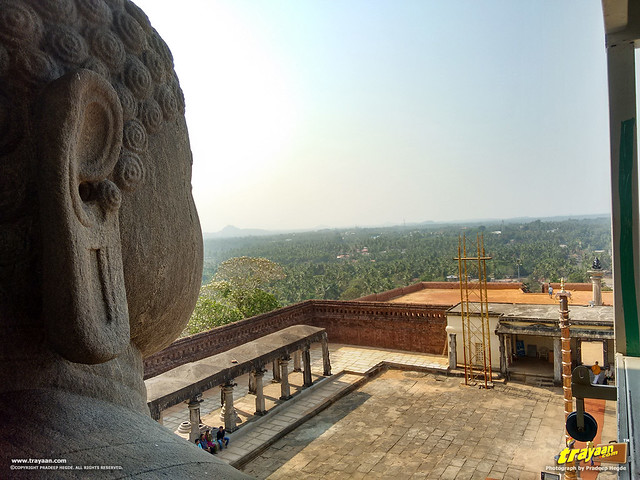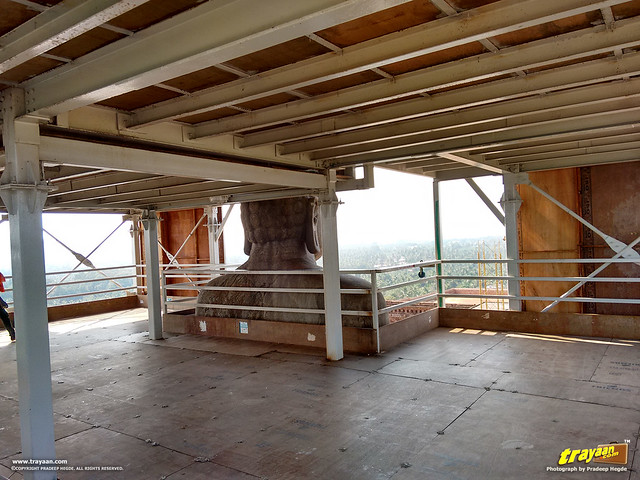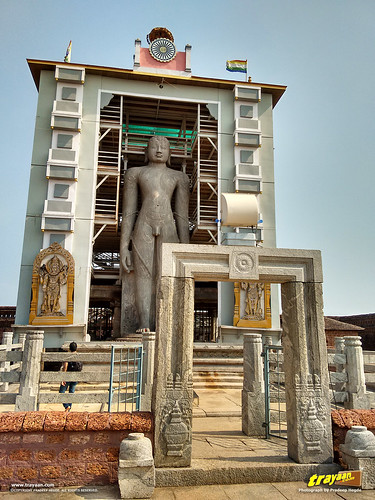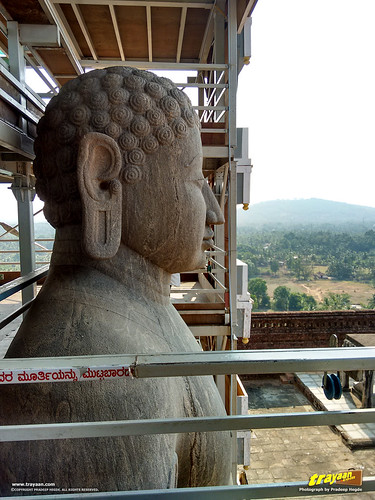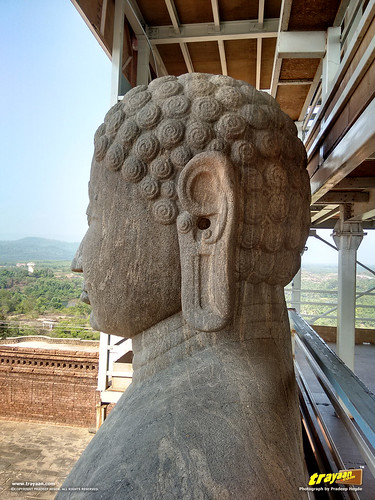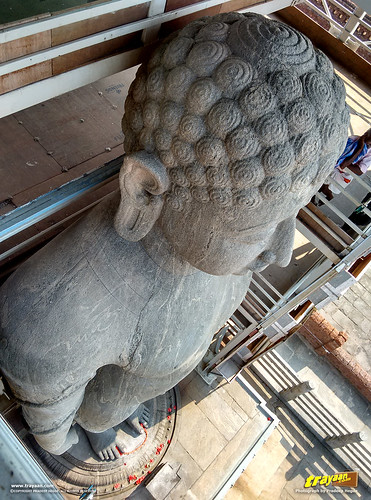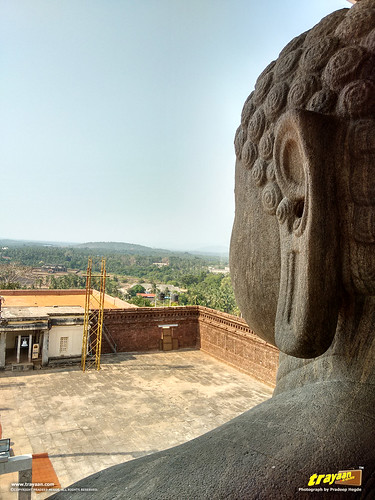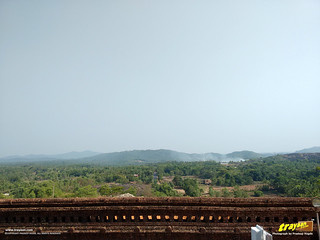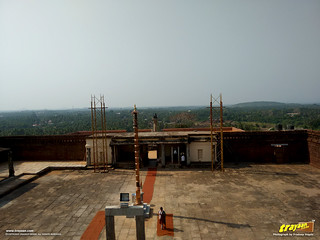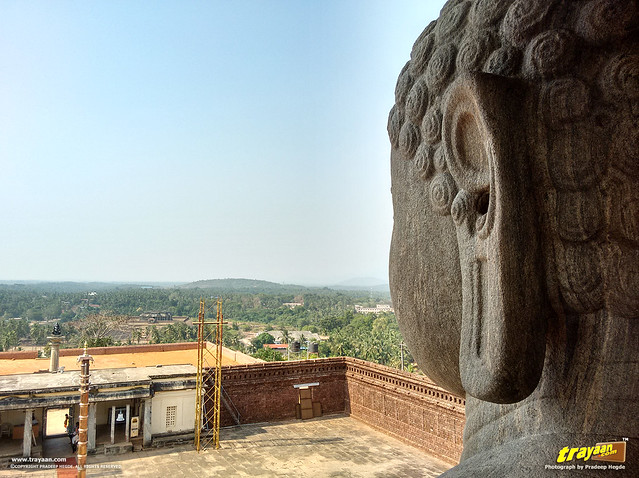The famed Jain heritage centre in Udupi district, Karnataka
On our second visit to Karkala and its Jain temples, we also visited the 12.8 metre or 42 feet tall monolith of Bahubali, the Gommateshwara. Built in 1432 CE, this 583 year old monolith in Karkala is the second largest monolith of Gommateshwara.
Jump to:
| Place Details & Brief History | Brief Legacy of Bahubali | Our Visit to Gommateshwara Hill
| Tips for Travellers | Getting There & Transportation | Food & Accommodations | Best times to visit
| Location Map | Get Directions | Nearby Attractions
| Place Details & Brief History | Brief Legacy of Bahubali | Our Visit to Gommateshwara Hill
| Tips for Travellers | Getting There & Transportation | Food & Accommodations | Best times to visit
| Location Map | Get Directions | Nearby Attractions
Karkala, a small town in Udupi district in Karnataka is home to several historical and significant Jain temples and monuments which are hundreds of years old like the 42 feet high monolith of Bahubali, the Gommateshwara.
Karkala is one of the places worth visiting if you happen to be at Udupi or Mangalore (now renamed as Mangaluru) on a tour.
The Gomateshwara hill in Karkala features the 12.8 metre tall or 42 feet high monolithic statue of Bahubali, well known as Gomateshwara. This is one of the five monoliths of Gomateshwara, in Karnataka. The nearly 583 year old Gomateshwara monolith of Karkala, built in 1432 CE, is the second largest monolith of Gomateshwara , the largest one is the monolith at Shravanabelagola.
Brief History of Karkala's Gommateshwara Monolith
The Kalasa-Karkala kingdom was established by the Bhairarasa Odeyas spanning from thirteenth to sixteenth century CE. Karkala was known as Pandya Nagari in the ancient times, later known as Karikallu (Black stone), and now as Karkala.The monolith of Bahubali on the peak of a granite hill, was erected by king Virapandya of Kalasa-Karkala kingdom in 1432 CE on the advice of his preceptor Lalitakirti. Measuring 12.8 m or 42 feet in height, it stands on a nearly 5 foot high moulded platform and is further enclosed by high brick walls.
Brief Legacy of Bahubali, the Gommateshwara
Bahubali was one of the several sons of the first Tirthankara, Rishabhdeva (also called as Rishabhanatha and Adinath) [1]. The Ādi purāṇa, a 10th-century Kannada text by poet Adikavi Pampa (~ 941 CE), which is the Kannada version of the Sanskrit Ādi purāṇa by Digambar Acharya Jinasena in 9th century CE, deals with the ten lives of the first tirthankara, Rishabha and his two sons, Bharata and Bahubali.According to Jain literature, Bharatha wants to become the supreme emperor and challenges all kings, who concede defeat, except his brother Bahubali. On the advice of their ministers, they decide upon having a series of contests rather than their armies indulging in bloodshed. Bahubali defeats his brother in all the contests and when he is just about to win the last one, which was a wrestling contest, he does not proceed to throw his brother on the ground and win it, but instead places him safely on the ground.
Bahubali, feeling disgusted by world and the worldly pleasures and infatuations, renounces his kingdom and discards all his material possessions of the world inlcuding all his clothes, and performs intense meditation a year in Kayotsarga posture, performing severe austerities and contemplating while standing in a motionless posture. He finally achieves omniscience through complete dispassion and peace of mind. He attains Nirvana from Mount Kailasa [1]. Bahubali is considered as an ideal man who conquers the worldly desires and vices. Bahubali is a symbol of the highest form of detachment.
Gomateshwara is also spelled as Gommateshwara, Gommateshwar, Gomateshwar, Gomteswar, Gomteshwar, and other variant spellings in English.
Our Visit to Gomateshwara Hill
On our recent visit to Karkala, we first headed towards the Gommateshwara hill. There is a Jain temple by the steps to the top of the hill. Climbing the steps, we came on top of the hill, with a complete view of surrounding Karkala. The amazing Chaturmukha Basadi, the four-faced Jain Temple is visible at a distance.The Gommateshwara monolith of Karkala stands inside high brick walls surrounding it, with only one entrance towards the North. Facing this entrance, there is a manasthambha pillar featuring a Brahma Yaksha in the seated position, and a kshetrapala (or kshetrarakshak) sculpture.

- Manastambha "column of honor" is a pillar that is often constructed in front of Jain temples. They are found before some Hindu temples too.
- Yaksha (Sanskrit: यक्ष yakṣa) is the name of a broad class of nature-spirits, usually benevolent, who are caretakers of the natural treasures hidden in the earth and tree roots. They appear in Hindu, Jain and Buddhist literature.
- Kshetra palas, like Dwara palas are the guards in service of the presiding deity. These dwara palas and kshetra palas sculptures or paintings will be seen before in Hindu, Jain and Buddhist temples.
At the time of our last visit in January, the statue was surrounded by temporary structure for the Mahamastakabhisheka. This ceremony is held every 12 years, where the statue is bathed and anointed with milk, water, saffron, etc.
Maha, means great; mastaka means head; abhisheka means anointing. Hence Mahamastakabhisheka means a great anointment to the head, in this case to the statue of Bahubali Gommateshwara.
In fact, the Gommateshwara statues in Shravanabelagola, Venur, Dharmasthala and the above one at Karkala are honoured with a Mahamastakabhisheka festival every 12 years in Karnataka . There is one Gommateshwara statue in Kumbhoj in Kolhapur district, Maharashtra, which is also honoured by Mahamastakabhisheka once every 12 years.
The mahamastakabhisheka ritual took place earlier in January this year, and to our surprise, the temporary structure still existed around the monolith. As it was open to the public, with a fee of Rs. 20 we went on it. During the mahamastakabhishekha ceremony, people stand on this structure and anoint the statue. This temporary structure around the monolith will stay till 5th of May this year until some more ceremonies are completed. After that it will be removed.
Standing on the top of this structure, we could see the entire surrounding Karkala area, alongwith the Ramasamudra lake and the amazing Chaturmukha Basadi.
It looks as though the Gommateshwara is watching the Chaturmukha Basadi on a rocky hillock towards north. From the south face entrance of the Chaturmukha Basadi, one can see the Gomateshwara monolith looking towards it.
Taking some time off here, resting in the cool breeze after a tiresome ride in the sun, we continued on our journey to the rest of places in Karkala.
We return to the rest of our Karkala trip in our next post.
Other notable Gommateshwara monoliths in Karnataka:
There are 5 monolithic statues of Bahubali in Karnataka measuring more than 20 feet in height.
- 57 feet high monolith at Shravanabelagola in Hassan District built in 981 CE
- 42 feet high monolith at Karkala in Udupi District built in 1430 CE
- 39 feet high monolith at Dharmasthala in Dakshina Kannada District built in 1973 CE
- 35 feet high monolith at Venur in Dakshina Kannada District built in 1604 CE
- 20 feet high monolith at Gommatagiri in Mysore District built in 12th Century CE
There is one Gommateshwara statue in Kumbhoj in Kolhapur district, Maharashtra, which is about 28 feet in height.
Karkala is a culturally rich place with several historically significant monuments, and a serene environment. It has all the potential to be a popular tourist destination.
Other attractions in Karkala
- Chaturmukha Basadi, the Tribhuvana Tilaka Jina Chaityalaya or Ratnatraya dhama, a four-faced symmetrical Jain temple built in 1586 CE
- Aane Kere Basadi, a four-faced symmetrical Jain temple.
- Other Basadis of Karkala
- The Great Manasthabha of Hiriyangadi, The Ananthapadmanabha (or Anantashayana) temple, built in 1567 CE, Ramasaudra Lake, and other temples.
- St. Lawrence church, popularly known as Attur Church, established in 1759 CE
- The Venkataramana temple, popularly known as “Padutirupathi", meaning West Tirupathi, built in 1537 CE.
- The Veeramaruti temple, originally built in 1539 CE, featuring over 15 feet idol of Lord Hanuman.
- Varanga (~24 Kilometres from Karkala town) - An idyllic village which is home to the 850 year old Kere Basadi (Lake temple) and the Neminatha Basadi, a 1200 year old Jain Temple.
Tips for Travellers
Transportation:
There are a good number of buses that ply to Karkala from Mangalore, Udupi etc. Hiring a cab or some 4 wheeler is a good option, as you can easily cover other nearby places of attractions worth visiting. If you are visiting Mangaluru or Udupi, then Karkala is well within a day trip. Nearby Moodabidri can also be covered.Karkala is about 17 kms from Moodabidri, 51 kms from Mangalore (Mangaluru) , 37 kms from Udupi via Moodubelle & 40 kms from Udupi via Manipal-Hiriadka road, 58 kms from Sringeri. Also, Agumbe is ~49 kms ; Venur is ~ 36 kms and Barkur is ~ 49 kms from Karkala.
See below map for various routes and directions.
Food & Accommodations:
There are a few decent places to have food in the town. There aren't much great hotels or lodges in Karkala. However, one can stay in Udupi or Mangaluru, and then travel to Karkala covering other significant places along.Best Times to visit
During the winter, between October to February or March, before the summer heat begins. It gets extremely hot and humid during summer (March/April to May/June). If you simply love the monsoon rains, go ahead in rainy season (around June to September). But keep an eye on the weather in the rainy season, as the roads this time may be bad.Location Map of Places to visit in Karkala
Directions Maps for Karkala
Get Directions to Karkala from your place of choice
Note: The directions will open up with Google Maps in a new tab.
Nearby Attractions
- Moodabidri - Featuring the Thousand Pillared Jain Temple (Saavira Kambada Basadi), and other historical Jain temples.
- Varanga (~24 Kilometres from Karkala town) - An idyllic village which is home to the 850 year old Kere Basadi (Lake temple) and the Neminatha Basadi, a 1200 year old Jain Temple.
- Mangaluru and Dakshina Kannada district features several beaches, temples and other places worth visiting
- Agumbe – The sunset view point in Agumbe at an elevation of 643 m (2,110 ft) is a very popular spot in Shimoga district.
- Udupi town and district features the famed sri Krishna temple and other temples, St.Mary's island, an ideal picnic spot, and many more.
- Chikkamagalur district features lush green mountains, waterfalls and landscapes. Mullayyanagiri, Kemmannugundi, Baba budangiri, Bhadra wildlife and river camps are some of the major attractions. It also has some fine Hoysala Temples, for example the Amrutesvara Temple at Amruthapura.
Other significant Ancient/Medieval Jain temples and structures nearby Mangalore and Mudabidri:
- Thousand Pillared Jain Temple (Saavira Kambada Basadi), and other historical Jain temples at Moodabidri (17 km from Karkala)
- 35 feet Gomateshwara Monolith at Venoor (36 km from Karkala)
- 39 feet Gomateshwara Monolith and Manjunatheshwara temple at Dharmasthala (63 km from Karkala)
References and useful external links for further reading
[1] Jain, Champat Rai (1929), Risabha Deva – The Founder of Jainism, Allahabad: The Indian Press Limited.
[2] Jain Statue of Gomateshwara - ASI Bengaluru circle
[3] BBC News Special: Audio slideshow: Spectacular Jain festival in Karnataka on BBC News
[4] Kayotsarga posture - Wikipedia, the free encyclopedia
[2] Jain Statue of Gomateshwara - ASI Bengaluru circle
[3] BBC News Special: Audio slideshow: Spectacular Jain festival in Karnataka on BBC News
[4] Kayotsarga posture - Wikipedia, the free encyclopedia
Please Note: trayaan.com is providing these external links, or links to external websites only for your convenience and the inclusion of any link does not imply the endorsement of the site. More»»




